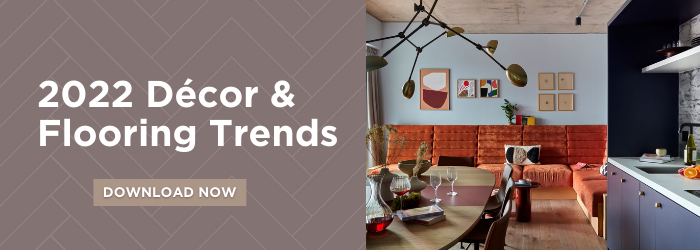Top 2022 Décor and Flooring Design Trends (+PDF)
Whilst unpredictable times continued throughout 2021, our homes have become somewhat of a sanctuary and place for self-expression this year. Many a renovation, refurbishment or room change-up have gone ahead as people spend more time adding personality to their spaces. With interests in interior design reaching new heights, we’ve predicted the décor and flooring designs we expect to be in full force throughout 2022...
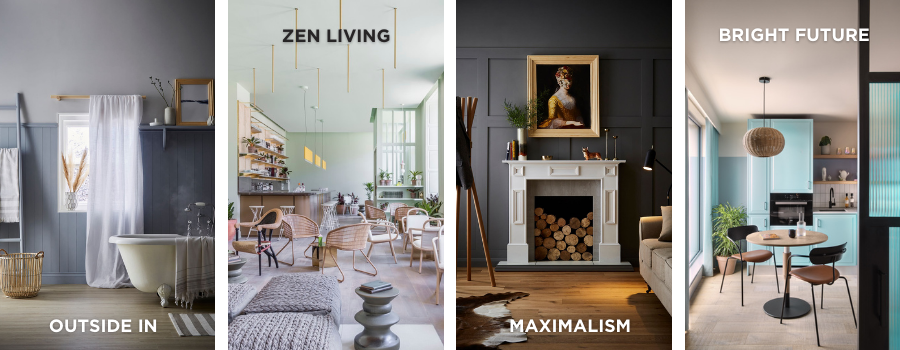
Outside in
Characterised by rustic finishes, modernist touches and natural wood, ‘Outside In’ is a trend that welcomes a harmonious blend of the rural outdoors with cosy décor. A relaxing colour palette of blue, grey and cream matches the bright and calming feel of our surrounding environment, paired with textured materials to engage the senses.
Not only has a calm and serene space become a key factor when it comes to choosing interior design styles, but so have sustainable materials. As the importance of shopping second-hand continues to resonate with more and more homeowners, locally handcrafted or re-purposed materials are becoming a popular choice when it comes to furnishings.
Flooring that celebrates the imperfections of raw woods, such as the Mayar Limed Oak, are both environmentally friendly and unique in aesthetic. Likewise, Eton Oak parquet flooring is a white-washed wood that offers a rustic grade and coastal feel against soft textures.

Zen Living
As we continue to take solace in our homes in 2022, the desire to surround ourselves with Biophilic designs to feel closer to nature has also increased. As has the importance of maintaining self-care and practicing mindfulness. Studies have found that natural and bright spaces are proven to improve health and wellbeing.* The combination of greenery and natural timber can offer a tranquil space that acts as the ultimate stress reliever, whilst also improving air quality and respiratory health.
‘Zen Living’ is not only a great trend to increase your mood, but an easy way to introduce more sustainable products into your home. By investing in quality materials with a long lifespan such as Atkinson & Kirby’s environmentally certified low maintenance wood flooring, homeowners can incorporate sleek designs that are self-sustaining. Wyvis Smoked Oak’s natural tones are timeless and will compliment any décor in years to come.
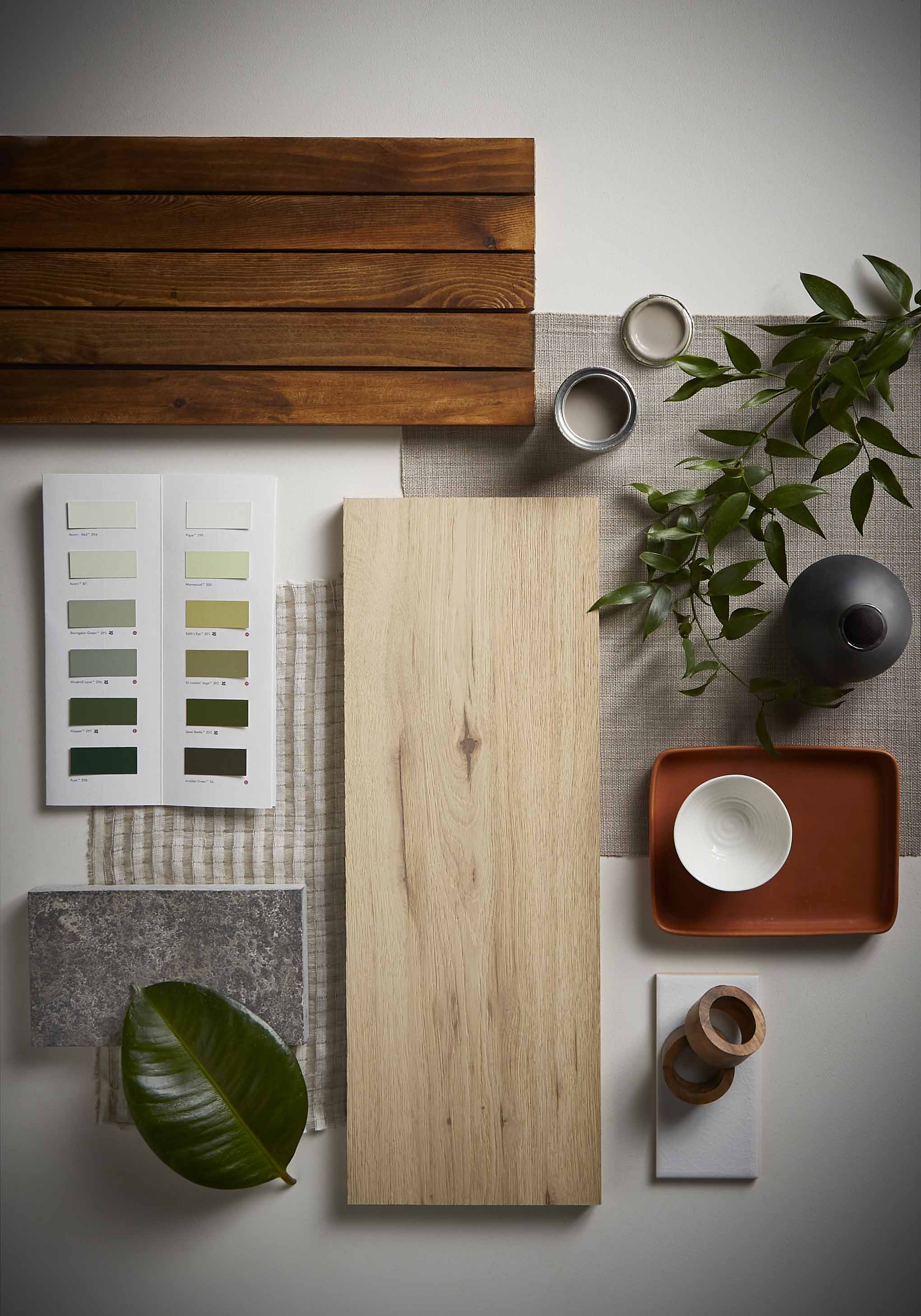
Maximalism
In an ode to nostalgic grandeur, ‘Maximalism’ is back and helping to transform our spaces into places of self-expression. Heavily influenced by the arts movement and the aesthetic of excess, where more really is more, maximalism is anything but boring. Bold pops of colour from true greens and deep blues to muted burgundy and orange make this trend the ideal way to bring a unique look to your home.
When it comes to flooring, deep toned parquet like Westminster Oak pairs well with loud colour palettes but maintains a traditional, vintage style. The rich toned timber of Sloane Smoked Oak provides a luxury and retro feel that when paired alongside abstract art and antiques can transfer your room into another time.
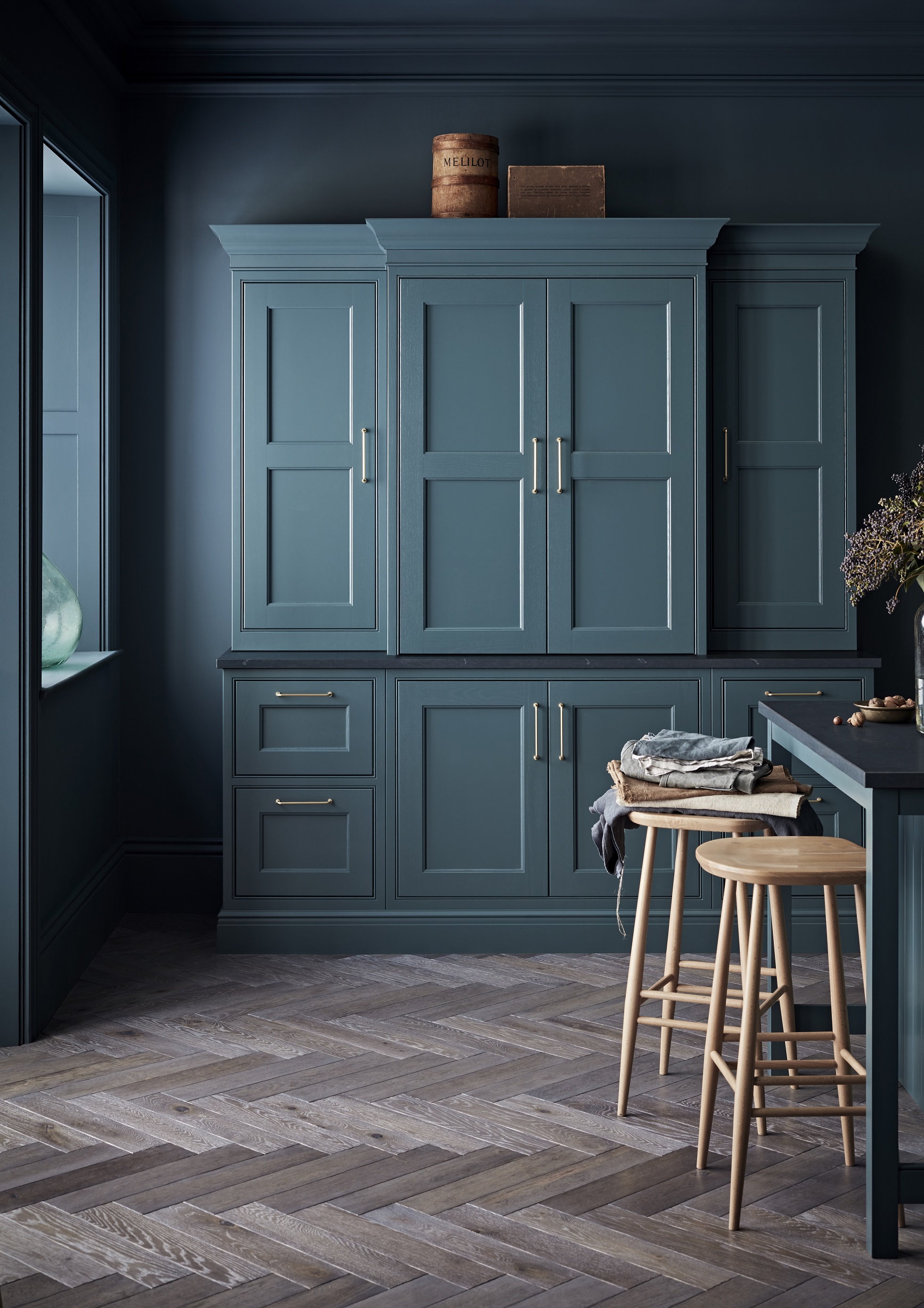
Bright Future
‘Bright Future’ is where retro and nostalgia meet soothing design elements that allow you to switch-off and unwind. Inspired by sci-fi aesthetics, this trend takes advantage of technological advancements and the digital elements within our homes to streamline our spaces.
Characterised by multi-functionality, futuristic décor, and floor zoning, ‘Bright Future’ is an energetic trend that encourages colour play. Pairing muted flooring with minimal knots such as Monoa Oak is the ideal way to enhance bold interiors and the use of colour blocking. Whilst Optilock parquet flooring like the Sonoran Oak can be useful for quick installations that still maintain a visibly clean space.
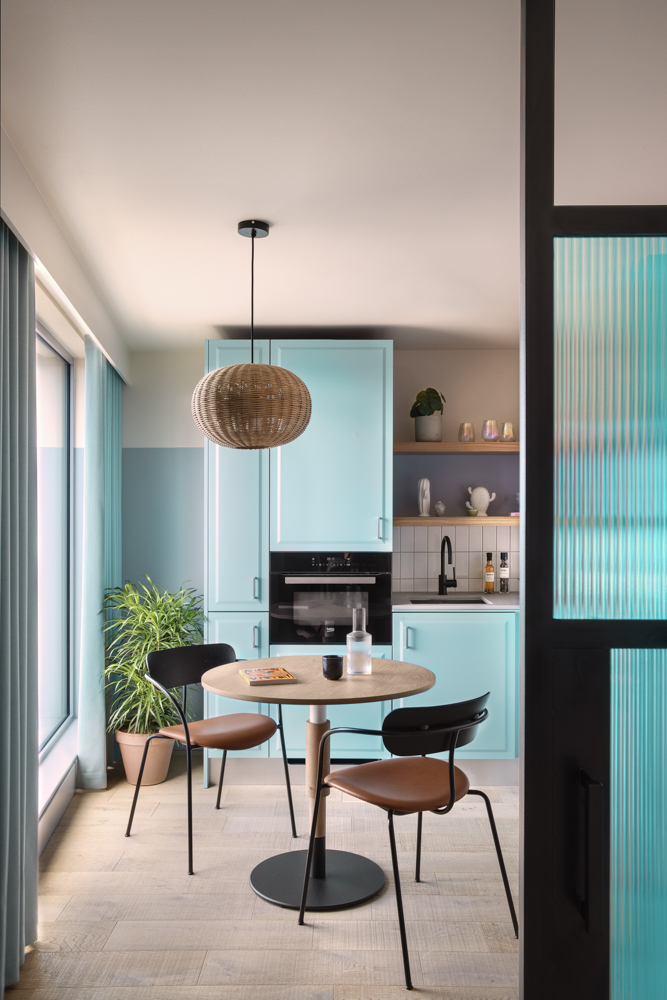
Trends Guide PDF
Find a world of inspiration in our 2022 Décor and Flooring Design Trends Guide. It features all four trends in detail, as well as moodboards and trend features. Download here.
*https://www.telegraph.co.uk/interiors/home/easy-home-decor-ideas-boost-happiness-wellbeing/
Manufacturer and supplier of premium hardwood flooring, Atkinson & Kirby, has relocated its headquarters to Chirk, North Wales, joining the company’s existing onsite manufacturing and distribution facility. As part of the ongoing development of the company, Atkinson & Kirby has relocated its office headquarters to join its existing manufacturing and distribution facility in Chirk. The move will improve both the service and quality of products by having all staff in one location, unifying working relationships between all departments, from marketing to distribution, as well as improving efficiency, customer service and delivery. Atkinson & Kirby still retains its office and distribution in Livingston. Tradition is an integral part of Atkinson & Kirby and the company is proud to remain one of a few British manufacturers of hardwood flooring, with a selection of solid flooring being produced in its Chirk mill. Tony Miles, CEO of Atkinson & Kirby, comments: “The consolidation of all offices to Chirk is a big move and demonstrates just how serious we are about British manufacturing and sustainability. “We are FSC® certified and take pride in the quality of wood we supply, with rigorous inspections at various stages of production, making sure the wood is always from a sustainable source. “We are a family business and above all, excellent quality and customer service are our priority. The move is already proving successful, with a unified workforce, improved communication and efficiency.
READ ARTICLEWhat is toxic flooring? Some forms of vinyl and laminate flooring are considered to be toxic. This is because certain types can contain reprocessed plastic and other toxic chemicals including cadmium, toxic phthalates and lead. These flooring materials can give off toxic fumes that can impact air quality through a process called off-gassing. By contrast, natural building materials and healthy flooring are made with products that are free from harmful chemicals. These types of flooring - including natural stone and wood floors - are considered 'low VOC' (Volatile Organic Compounds). Sometimes, even those who shop carefully and make lifestyle choices to build a 'chemical-free house' can find that they've overlooked their flooring manufacturers and products. What is off-gassing? In simple terms, off-gassing is the process by which dangerous chemicals are released into the air. An easy-to-recognise example might be the smell of wet paint - when you sniff that recognisable scent, it means the chemicals in the paint have risen into the air. Of course, some smells and fumes are harmless to our health, but others - particularly those with dangerous chemicals or toxins - can have a serious impact. Who is at risk from off-gassing? Anyone can be affected by the toxic chemicals in certain flooring and building materials. However, typically babies and young children are among the most susceptible to the effects of toxic air quality. Adults and those with weakened immune systems or respiratory issues can also experience strong symptoms from inhaling the fumes. In the case of toxic flooring - for example, certain types of vinyl floors - it's likely that anyone who spends a lot of time close to the material itself will be the most affected. This can mean toddlers crawling around, as well as pets. What are Volatile Organic Compounds (VOC)? Volatile Organic Compounds (VOCs) are gases that are emitted into our air from various products. They can be standalone harmful chemicals that are dangerous on their own, however sometimes VOCs react to other gases or chemicals to create other pollutants. In flooring material, VOCs can commonly be found in products like stains, varnishes, adhesives and certain finishes. Natural materials - such as solid wood flooring or hardwood flooring - are generally classed as 'low-VOC'. High levels of exposure to VOCs can be harmful to the environment and health. What are formaldehyde emissions and how do they relate to low VOC flooring? Formaldehyde emissions are some of the most common VOCs. The EPA classes formaldehyde fumes as a 'probable human carcinogen'. Formaldehyde is sometimes used for its bonding qualities, so can be found in plywood, top coats, vinyl adhesive and more. It can irritate the eyes, nose, throat and skin. Significant exposure can also cause cancer. Once you know to look out for formaldehyde fumes, you'll be able to identify which flooring is the safest and best to use. A product labelled as ULEF (ultra-low emitting formaldehyde) is certified at the highest category and is the best choice for homes - though it likely contains formaldehyde, it emits fumes at extremely low levels. Formaldehyde can also be found in the emissions from vinyl flooring adhesive and the base layer of many laminate flooring types. A product labelled NAUF (no added urea formaldehyde) is essentially the next best thing. These products don't use urea formaldehyde, which causes the fumes to be released for the entire life cycle of the product. Instead, these products use alternative glues and release around 90% fewer formaldehyde emissions. Read on for our guide to non-toxic flooring. CARPET Carpet has traditionally been a popular choice of flooring, however as we become more aware of the health risks associated with carpet flooring, many people are searching for more natural eco-friendly flooring options, also known as green flooring options. There are many areas in which harmful chemicals could be used within synthetic carpet, including the dye used to colour the carpet, adhesives used to bind carpet fibres, and the dangerous chemicals used to create resistance to stains. New carpet installation is a large contributor to indoor air pollution - a recent EU study identified over 59 hazardous substances found in carpets. Synthetic carpet can hold these dangerous chemicals for months, if not years. However, there are ways to limit exposure. If you are set on choosing a carpet or a rug for your home, place the rug outdoors or in a well-ventilated area for at least a week, as the first few weeks are when the carpet expels the most toxic fumes. HARDWOOD FLOORING There are two types of hardwood flooring, solid or engineered. When installing hardwood floors the most common option is to glue the floor down. There are many safe, non-toxic glue options that you can use, speak to your installer about sourcing non-toxic glue. Alternatively, flooring profile options have advanced including 5G click, which simply clicks together allowing you to ‘float’ the floor, without requiring glue. SOLID HARDWOOD FLOORING Solid hardwood flooring is considered the safest and least toxic option as it’s completely natural and free from any toxins. Solid hardwood floors are made of planks milled from a single piece of timber, which makes it a healthy flooring option. Solid wood flooring has many advantages, including its durability, with proper maintenance and care, solid wood flooring can last a lifetime. This type of flooring is also zero-VOC and has no off-gassing qualities since it's made with natural materials. For an even more eco-friendly option, choose 100% FSC-certified wood floors, as the timber used to produce the floor comes from legal sustainable sources. However, as solid hardwood floors are 100% wood they can’t be used in moist areas, including bathrooms and basements. ENGINEERED HARDWOOD FLOORING Engineered hardwood flooring has low toxicity and similar advantages to solid hardwood flooring, but it can also be used with underfloor heating. Engineered wood floors are made from multiple layers of engineered wood for extra stability. Because it is created using natural wood, it has zero to low VOC levels. LAMINATE FLOORING Laminate flooring mimics hardwood, but instead uses synthetic wood. Unfortunately, due to the toxins and chemicals in the bonding adhesives, laminate isn’t the safest option for non-toxic flooring. CERAMIC TILES Ceramic tiles are another safe flooring option, as the tiles are usually made from non-toxic materials. However, as tiles require a thin-set mortar for the tiles to adhere to, as well as grout to fill the spaces between each tile. While the tiles themselves do not contain these harmful chemicals, it is possible that these products do. Therefore, it’s a good idea to check all components when opting for tile flooring. VINYL FLOORING Vinyl flooring and luxury vinyl plank types have become extremely popular in recent years, thanks to their durability and budget-friendliness. However, while good quality vinyl plank and tile is a viable option for flooring projects, some types of vinyl flooring have historically been found to have phthalates in them, which can be harmful due to off-gassing. These days, most vinyl flooring from quality, trustworthy manufacturers have drastically reduced VOC levels. Specifically, vinyl plank and luxury vinyl plank or luxury vinyl tile flooring are low in VOCs and at low risk for off-gassing. Rolled vinyl flooring is typically higher in off-gassing risk levels. IN SUMMARY When choosing your flooring, it’s best to opt for the most natural materials and products for a non-toxic home that is safe for pets and children. Atkinson & Kirby is committed to supplying non-toxic hardwood flooring, with solid hardwood floors being manufactured at our mill in Britain. All of our hardwood floors are FSC® and PEFC®, meaning you can be sure the timber was sourced from sustainable forests. View our solid hardwood floors or engineered hardwood floors. If you would like to order a sample or speak to one of our experienced customer service team, contact us here.
READ ARTICLE
